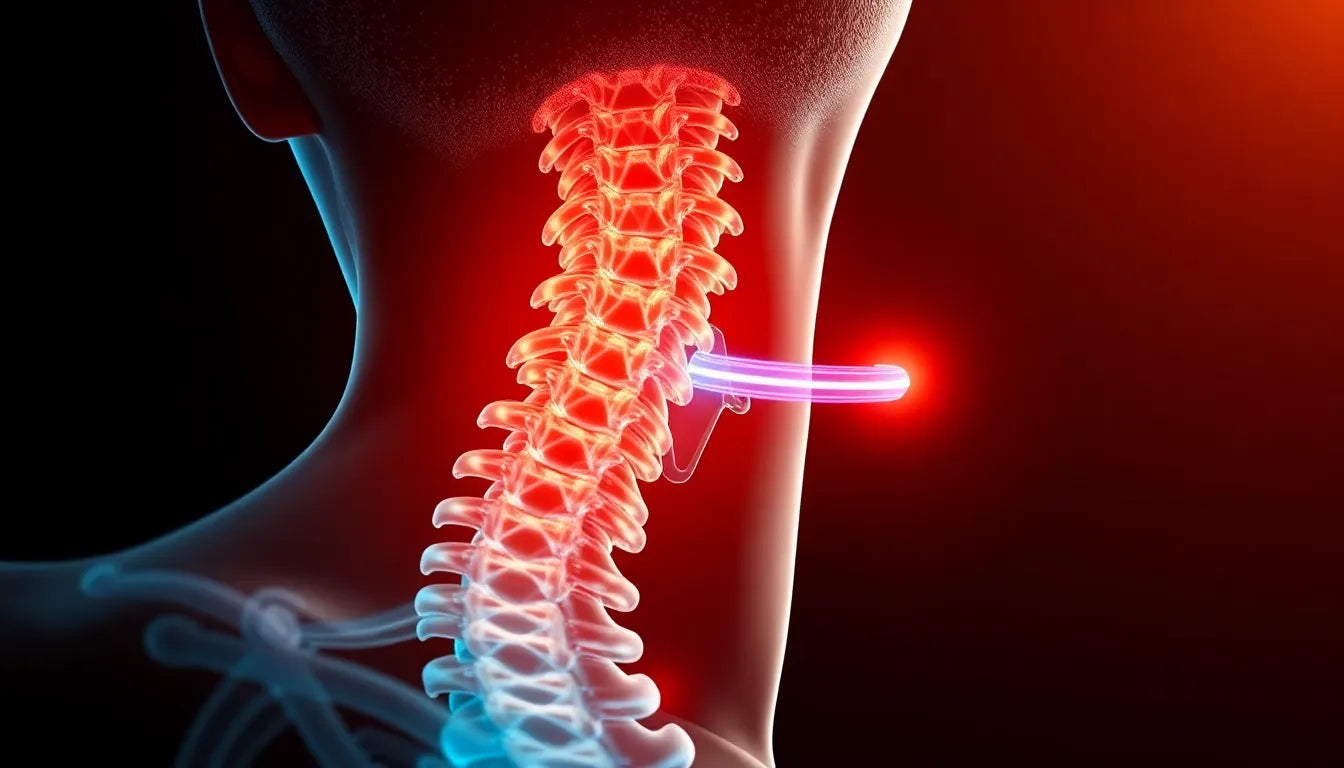A herniated disc, often referred to as a slipped or ruptured disc, is a condition where the soft, gel-like center of a spinal disc pushes through a crack in its tougher exterior casing. This protrusion can irritate nearby nerves, leading to a variety of symptoms that can significantly impact daily life. While many people may experience only minor discomfort, for others, the effects can be severe and debilitating.
understanding the impact of a herniated disc
Herniated discs are relatively common and can occur in any part of the spine, though they are most frequently found in the lower back or neck regions. The symptoms can range from mild discomfort to severe pain, numbness, or weakness in an arm or leg. This variability makes it crucial to understand the condition's seriousness, as it can either be a minor nuisance or a sign of a more significant health issue.
why it matters: symptoms and scenarios
Consider this: Is your persistent back pain just a minor inconvenience, or could it be a sign of something more serious, like a herniated disc? The spectrum of symptoms associated with a herniated disc is broad. Some individuals may experience a dull ache, while others face intense pain that disrupts their daily activities. The discomfort may worsen with movement, prolonged sitting, or standing, and can sometimes lead to muscle weakness or numbness.
The seriousness of a herniated disc lies in its potential to affect your quality of life. If left unaddressed, it could lead to more severe complications, making it essential to recognize when the condition demands urgent medical attention.
setting the stage for urgent attention
This blog post aims to delve into when a herniated disc requires immediate medical evaluation. Understanding the symptoms and potential complications is crucial for making informed decisions about your health. In the sections that follow, we'll explore the severity and symptoms of herniated discs, discuss potential serious complications, and outline treatment and recovery options. By the end of this post, you'll be equipped with the knowledge to determine when it's time to seek professional help and how to manage the condition effectively.
severity and symptoms of herniated discs
Understanding the symptoms of a herniated disc is crucial for determining its seriousness. The condition can manifest in a wide range of symptoms, which can vary significantly depending on the location of the herniation. For instance, a herniated disc in the cervical spine (neck region) may lead to pain and weakness in the arm or hand, whereas a herniation in the lumbar spine (lower back) can result in lower back pain, leg pain, and even foot drop.
Common symptoms include:
- Pain radiating through an arm or leg
- Burning or tingling sensations
- Muscle weakness
- Pain exacerbated by movement, sitting, or standing for extended periods
- Numbness or tingling in affected areas
While these symptoms can be uncomfortable, they are not always indicative of a serious condition. However, certain symptoms signal the need for immediate medical evaluation. These include:
- Loss of bladder or bowel control
- Saddle anesthesia, or numbness in the groin area
- Significant muscle weakness
potential for serious complications
In some cases, a herniated disc can lead to serious complications. The most concerning scenarios involve conditions like cauda equina syndrome and myelopathy. Cauda equina syndrome is a rare but severe condition where the bundle of nerves at the end of the spinal cord is compressed, leading to symptoms such as incontinence and severe neurological deficits. Myelopathy, on the other hand, involves damage to the spinal cord itself, which can result in long-term neurological issues if not addressed promptly.
To better understand the differences in severity, consider the following comparison:
| Common Herniated Disc Symptoms | Serious Complication Symptoms |
|---|---|
| Pain and numbness | Loss of bladder/bowel control |
| Muscle weakness | Saddle anesthesia |
| Burning or tingling | Significant muscle weakness |
risk factors for severe outcomes
Certain factors can increase the risk of developing serious complications from a herniated disc. These include age, as older adults are more susceptible to disc degeneration; a high level of physical activity, which can put additional stress on the spine; and pre-existing spinal conditions that may exacerbate the impact of a herniated disc.
treatment and recovery options
For most individuals, herniated discs can be managed with conservative treatment options. These typically include physical therapy, medications such as pain relievers and anti-inflammatories, and lifestyle modifications to reduce strain on the spine. Conservative management often leads to significant improvement within four to six weeks.
In cases where symptoms persist or are severe, surgical intervention may be necessary. Surgery is usually considered a last resort and is recommended when there is significant neurological impairment or when conservative treatments fail to provide relief. Surgical options include discectomy, where the herniated portion of the disc is removed, and spinal fusion, which stabilizes the affected area. Each surgical procedure carries its own set of benefits and risks, which should be thoroughly discussed with a healthcare provider.
In conclusion, while a herniated disc is not always serious, understanding the symptoms and potential complications is essential for making informed decisions about treatment. Recognizing when to seek urgent medical attention can prevent severe outcomes and improve overall recovery.
preventative measures and ergonomic aids for herniated discs
Preventing a herniated disc involves a proactive approach to spinal health, focusing on posture, ergonomics, and physical fitness. Maintaining good posture is crucial, as it reduces the strain on spinal discs. Ergonomic aids, such as supportive chairs and adjustable desks, can significantly alleviate pressure on the spine, particularly for those who spend long hours sitting. Additionally, incorporating regular exercise that strengthens the core and back muscles can provide better support for the spine, reducing the risk of disc herniation.
Ergonomic products play a vital role not only in prevention but also in recovery from a herniated disc. These products are designed to support natural alignment and reduce undue stress on the spine, which can help manage symptoms and prevent recurrence. For example, lumbar support cushions can maintain the natural curve of the lower back, while standing desks can promote movement and reduce prolonged sitting, which is often a contributing factor to disc issues.
long-term outlook for herniated disc recovery
The long-term prognosis for individuals with a herniated disc is generally positive, especially with early intervention and consistent management. Most people experience significant improvement with conservative treatments within a few weeks. However, ongoing management is essential to prevent recurrence and complications. This includes adhering to prescribed physical therapy exercises, maintaining a healthy weight, and avoiding activities that place excessive strain on the spine.
For those who undergo surgical intervention, the recovery process may take longer, but many patients report relief from severe symptoms post-surgery. It is important to follow the surgeon's postoperative care instructions to ensure optimal recovery and to prevent future issues. Regular follow-up appointments with healthcare providers can help monitor progress and address any concerns promptly.
frequently asked questions
What are the first signs of a herniated disc?
Initial symptoms of a herniated disc often include localized back or neck pain, which may radiate to the arms or legs. You might also experience tingling, numbness, or weakness in the affected areas. If these symptoms persist or worsen, it is advisable to seek medical advice to determine the underlying cause.
Can a herniated disc heal on its own?
Yes, many herniated discs can heal naturally over time. The body's inflammatory response can help absorb the protruding material, reducing pressure on the nerves. Factors influencing recovery include the severity of the herniation, overall health, and adherence to conservative treatment methods such as physical therapy and rest.
When should I see a doctor for a herniated disc?
It is crucial to seek medical attention if you experience severe symptoms such as loss of bladder or bowel control, saddle anesthesia, or significant muscle weakness, as these may indicate a serious condition requiring urgent care. For persistent or worsening pain and discomfort, consulting a healthcare professional can help in developing an appropriate treatment plan.
What can I do to prevent a herniated disc?
Preventative measures include maintaining a healthy weight, practicing good posture, and engaging in regular exercise to strengthen the core and back muscles. Using ergonomic aids, such as supportive chairs and desks, can also help reduce spinal strain. Avoiding smoking and managing stress are additional factors that contribute to overall spinal health.


















